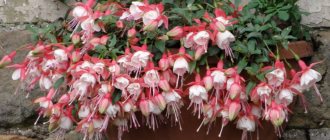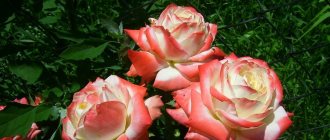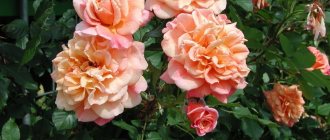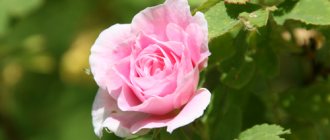The tropical plant ficus today can be found in almost every apartment or house. He does not need special care or scrupulous attitude. The flower is not capricious and unpretentious, but at the same time it has magical beneficial properties that have a positive effect on human health and the energy of the entire room.
The leaves of all types of ficus perfectly filter oxygen, purify it from dust and harmful microorganisms, as well as gases. The plant is widely used in folk medicine. Its juice is used to make infusions for arthritis, radiculitis, mastitis and other bone, muscle and inflammatory diseases. In ancient times, it was believed that ficus drove away evil spirits and attracted positive energy into the house.
This is interesting : ficus became popular at the end of the 19th century. It was used to decorate various halls and rooms. In humid climates it can reach up to 40 meters in height.
In our article you will find not only a photo of the ficus “Black Prince”, but also detailed instructions on how to properly care for this interesting and unusual plant at home.
Ficus Black Prince: tips for care, propagation and replanting
Ficus Black Prince is another variety of Ficus Rubber, which today is one of the most popular in home floriculture.
This plant with such a noble name came to us from Southern Indonesia, Northeast India, West Africa and Nepal. There, in its homeland, Ficus Elastica Black Prince grows up to 40 m in height - thus, it is used industrially to produce rubber. But how did he conquer flower growers involved in ornamental cultivation? It's simple - its large, rounded leathery leaves up to 25 cm in length and up to 20 cm in width, of a deep, dark green color, have done their job. In addition, the trunk and petioles have the same color with a reddish tint. The central vein is clearly visible from both sides of the leaf and has a brown tint. Ficus Black Prince photo
Ficus - signs and superstitions about pregnancy
Since ficus is the patron of family and home, it can help you get pregnant. In order for you to have heirs as quickly as possible, place it in the marital bedroom, and pregnancy will not take long to occur. This helps even those who have tried almost every way to have children and failed.
There are many superstitions about how to use ficus for pregnancy. Some of them believe that it is not even necessary to plant it at home, it is enough to sometimes walk around a tub with this plant in the nude. For those who do not want to grow a ficus and take care of it, a borrowed plant can help. But you still have to take care of it and water it on time, because home flowers only help those who treat them well and do not provoke their withering and disease.
Should we trust the signs of our ancestors, or the traditions of other peoples regarding this plant? Decide for yourself. However, it should be remembered that our ancestors were never mistaken regarding everything related to the subtle world. So perhaps this type of domestic flora is simply not suitable for our people.
Ficus is a popular plant for growing indoors. It is valued for its unpretentiousness and decorative properties. With proper care and good maintenance conditions, these plants practically do not get sick and delight their owners with beautiful leaves.
In nature, they grow in Indonesia, India, Africa, Burma and the island of Sri Lanka. Ficus Black Prince was brought to European countries in the 19th century and began to be grown in greenhouses and as an indoor flower.
Caring for ficus Black Prince at home
How this variety differs from Elastica is clear, but what are the similarities? But now the best part is that the Black Prince does not require special vigilance or strict care at home, and adapts quite well to life in a residential area.
- Lighting : like other rubber plants, Ficus Black Prince loves bright, but diffused light. In the summer, you will be very grateful for the time spent in the fresh air.
Do not forget to shade the plant from direct sunlight, which can leave burns on the leaves.
- Temperature : the most suitable temperature regime for Elastic will be +18 °C - +24 °C in the summer season and +16 °C - +18 °C in winter.
- Watering : The Black Prince requires moderate watering - when the top part of the soil has already dried out.
Do not allow the soil to become waterlogged - this will lead to rotting of the root system.
- Air humidity : with average humidity in the room, the ficus will be quite comfortable, but you can wipe the leaves from dust with a damp sponge. You can also add spraying on hot days or the heating season.
- Transplantation : transplantation is carried out in the spring. Young plants need to be replanted every year, while enlarging the pot. Older ficus plants do not require frequent replanting; they can be replaced with a larger pot when the roots have occupied the entire earthen ball.
The most suitable soil for ficus will be one that contains equal parts of peat, leaf and turf soil, compost and coarse sand.
- Fertilizing : fertilization is carried out during the growth period: from spring to autumn. For this purpose, universal mineral or organic substrates are used.
- Reproduction : like its brothers, the Black Prince reproduces by cuttings and air layering. For the first method, you need to cut the cuttings to 15 cm with one or two healthy leaves. The cut must be cleaned of milky juice and powdered with a root growth stimulator. Next, the petiole takes root in water or an earthen substrate at a temperature of +22 °C - +25 °C.
When separating and working with the cut, do not forget to protect your hands with gloves, since the milky sap that ficus trees secrete can cause irritation or an allergic reaction.
When propagating by air layering, you need to make an incision on the trunk, insert a piece of glass, a piece of wood into it, or fill it with coarse sand. Next, you need to wrap the incision with damp sphagnum moss and polyethylene. As soon as the root system begins to develop, the shoot can be separated and transplanted into the ground.
Ficus rubbery (Ficus elastica) - a familiar stranger
Ficus rubber in a pot
- Indoor cultivation;
- Care;
- .
Ficus rubbery , also known as ficus elastica, is the most famous ficus in indoor culture. This is what our grandmothers and great-grandmothers grew in their homes. Then this plant was forgotten for many years and only now, thanks to Dutch supplies, has settled in our homes again.
In nature, this ficus grows as a large tree up to 30 m tall and forms aerial roots that descend to the ground and take root, providing additional nutrition to the plant. The leaves are dark green, glossy, oval-shaped, up to 30 cm long. The young leaf is always pinkish in color and has a veil that flies off after the leaf unfurls.
Indoor cultivation
Only young plants are grown indoors. Under normal maintenance conditions, this ficus should produce 1 new leaf per week from spring to autumn, without losing the lower leaves. Does not bloom indoors.
Ficus rubber has a huge number of varieties, differing in color and leaf size. The most popular varieties for home cultivation:
Ficus rubber variety "Robusta"
Robusta - distinguished by large dark green monochromatic leaves. One of the most unpretentious varieties.
Ficus rubber variety "Melany"
Melanie is the best variety for growing in small apartments. A smaller, unpretentious plant, with dark green leaves, smaller than other varieties - about 15-20 cm long. In addition to its compactness, this variety has another significant advantage - it bushes well, so crown formation does not cause problems.
Ficus rubber variety "Belize"
Belize is a variety with a beautiful tricolor leaf color - green in the center, pink and white at the edges. The central vein of the leaf and the spathe are pink. The most unpretentious variety of variegated ones, but requires more intense lighting and warmer conditions.
Ficus rubber variety "Tineke"
Tineke is a variegated variety, with a green leaf in the center and chaotic spots of white and pistachio along the edges. The variety is more capricious and requires careful care.
Ficus rubber variety "Black Prince"
Black Prince is a variety with dark burgundy leaves. Unpretentious, but looks good only in bright rooms.
Ficus rubber variety "Abidjan"
Abidjan is an unpretentious variety with very dark leaves.
Location
Prefers a bright, but not sunny place. Direct sunlight causes leaf burns and leaf fall. The ideal place for this plant is near a window with a drawn curtain.
And only near the northern window the ficus can not be shaded. Variegated varieties require lighter content, but they also do not tolerate direct sun rays.
When kept in the shade, the color becomes duller and the variegation is less noticeable.
It does not tolerate drafts well and reacts to them by dropping leaves. The plant can be placed near an open window, but you must make sure that there is no flow of cold air.
In winter, ficus should be placed away from heating radiators. For variegated varieties in winter, additional lighting with fluorescent lamps is desirable.
Temperature
The ideal temperature is 18-25 °C. When the temperature rises above 25 °C, the plant requires regular spraying. A decrease in temperature below 16 ° C can lead to the loss of some leaves.
The critical temperature for ficus elastica is 12 °C, however, non-variegated varieties can withstand a short-term decrease in temperature to +5 °C, provided that the earthen coma is kept warm.
The earthen clod should not be allowed to cool, as in this case the plant may shed its leaves.
In winter, it is better to keep ficus at a temperature of +16-18 °C, as this will prevent the growth of smaller leaves.
Watering
Requires regular but moderate watering. Water for irrigation should be warm and well settled. If the plant is kept in a warm room in winter, the earthen ball should be constantly moist.
Humidity
Responds well to spraying with warm boiled or filtered water. Spraying with unboiled water leads to the formation of unsightly calcareous spots on glossy leaves. In winter, if the plant is kept in a cool room, spraying is not required.
Large ficus leaves must be kept clean - regularly wiped on both sides with a damp sponge or soft cloth.
Top dressing
During the period from spring to autumn, fertilizing is done once every 2 weeks with a special fertilizer “for ficuses” or a complex fertilizer for decorative deciduous plants. Fertilizer is applied with water for irrigation and spilled over an already watered, moist clod of earth.
Transfer
Since Ficus elastica is a fast-growing plant, it requires regular replanting and a larger pot.
You should not immediately plant a small plant in a large pot, as this will lead to rapid growth of the root system to the detriment of the above-ground part of the plant.
The pot is selected 3-5 cm larger in diameter and 5-6 cm deeper than the one in which the ficus is currently growing. At the bottom of the pot it is necessary to pour a layer of drainage 3-4 cm thick.
The soil for planting should consist of peat and turf soil, leaf humus and river sand in a ratio of 1:1:1:1. You can use purchased specialized soil for ficuses or universal soil, to which it is advisable to add a little sand.
Crown formation
Since only young specimens of ficus rubber are grown indoors, they usually grow with one trunk. Therefore, they are usually planted with several plants in 1 pot. If you have a single plant, you need to take measures to form a beautiful crown.
- To do this, cut off the apical stalk with 3-4 internodes from a plant grown to a height of 50-70 cm. The cutting takes root and the plant produces lateral shoots. Subsequently, the rooted cutting can be planted next to the main plant to form a bush. If the plant is small, you can simply pinch the top, but there is a high probability that instead of the removed growth point, only 1 replacement sprout will grow;
- In order to stimulate branching, without trimming the crown, you can strongly bend the crown, fixing it in this position. Then the bud, which will be at the highest point of the trunk, will begin to grow. After this, the barrel can be returned to its normal position;
- You can also cause a branch to appear by piercing the trunk with a thick needle to 1/3 of its thickness. In case of several punctures, a sprout will grow from the lowest puncture. Therefore, it is better to start stimulating the appearance of branches from the top of the plant, gradually moving down.
Ficus rubbery in the interior
In general, Ficus elastica is one of the most unpretentious types of ficus, which does not require (except for variegated varieties) the creation of special conditions of detention.
However, when choosing this type of ficus, you should take into account that this is a rather large and fast-growing plant, the crown of which cannot be shaped by cutting.
Therefore, the plant must be regularly rotated 90 degrees to make leafing more uniform. I suggest watching a very interesting video about how to properly replant ficus elastica.
Source: https://Potted-Plants.ru/fikus-elastika/
Description and features
Under natural conditions, ficuses, without any obstacles, grow up to 40 meters in height , and outwardly bear little resemblance to the indoor specimens that flower growers are accustomed to.
Powerful aerial roots form the tree trunk and support its high branching crown. In the room, ficuses also begin to branch if there are suitable conditions for this , but small apartments do not contribute to this.
The height of the Black Prince will depend on the size of the pot in which it is grown and the height of the ceilings in the room. The root system of the flower is very powerful and branched.
And aerial roots also grow, designed to collect moisture from the atmosphere and maintain the crown. If a leaf or petiole is cut, a white milky sap will appear.
The distinctive features of the Black Prince are its large leaves of a dark green color, which in certain lighting look almost black , for which it received its name.
In the morning and evening, in diffused light, the plant looks dark; in bright sunlight, the color becomes lighter. The upper leaf, while young, is colored reddish .
The length of the leaves is from 15 to 25 cm, and their width is up to 20 cm; in the center of each leaf there is a burgundy vein, as in the photo.
How to properly care for the Black Prince
This is a grateful plant; if you provide it with good care at home, it will delight the gardener with beautiful foliage and a healthy appearance . Suitable soil, the optimal pot size and a convenient location in the house are what it needs for successful growth.
The Black Prince can adapt to different conditions of detention, but the only thing he doesn’t like is rearrangements. It is better to immediately, even before purchasing, determine a place for it in the house and always keep it there.
What else can destroy the health of a flower? He does not tolerate drafts in the room, so find him a quiet place where he will feel good. And most importantly, it does not tolerate waterlogging of the earthen coma, the roots may begin to rot , then the ficus will need urgent treatment.
Composition of soil for a flower
The Black Prince is picky about the composition of the soil; it is necessary to correctly compose the soil mixture for replanting it. Ficus roots need to breathe, so the best pot for it is clay , without glaze or other external coating. It likes the addition of natural fertilizers and slightly acidic soil.
The soil for the plant should be fertile and light enough. Land containing clay is contraindicated for it, since water stagnates in it .
For a young ficus, you need to prepare the soil with the following composition (in equal parts):
- peat;
- leaf humus;
- sand.
An adult plant needs denser soil ; the following composition is prepared for it: 2 parts of leaf humus, one part each of sand and turf soil.
Knowing these recipes, the gardener can prepare the soil himself at home. The soil mixture should be loose; for this, some coarse sand is added, as well as charcoal .
Temperature and lighting
In summer, ficus requires an ambient temperature of 18 to 25 degrees, and in winter – at least 16.
In hot weather, the plant will suffer from a lack of water , but since the Black Prince does not like waterlogging of the soil, irrigating the leaves with a spray bottle will be an additional source of moisture.
In autumn and winter, in a cool room, it needs less watering than in summer, since its vital activity slows down.
For ficus, the best location in the house will be the south, east or southeast side with good lighting. From lack of sun, the leaves lose their rich color .
Since the Black Prince is a southern flower, it needs sun in winter too. Provide the plant with enough sunlight.
If there is a lack of light in winter, the shoots will stretch and the trunk may bend . This problem is solved by slightly lowering the room temperature (up to +18 degrees) and reducing watering.
Watering and loosening the soil
It is important to learn how to water your ficus correctly; it loves regular and moderate watering . The water should be settled and soft, and its temperature should be no less than room temperature.
In summer it is watered 2-3 times a week ; in September it is necessary to begin a gradual reduction in watering. In winter, the soil is moistened 1-2 times a week.
If the plant is contained in plastic peas, then it needs to be watered less often, and in clay pots (without glaze), moisture evaporates not only from the surface of the soil, but also through the walls of the pot .
This means you need to water it a little more often. Loosen the top layer of soil so that air can reach the roots and moisture in the pot does not stagnate. If this happens, the plant will become sick and begin to shed its leaves .
How to feed correctly
This video explains how to care for a houseplant, the ficus rubber plant, and what to feed it with.
In summer and spring the flower needs to be fed. In the spring, when the days become sunny, the ficus should begin to be watered with nutrient solutions . In summer this is done once every two weeks. It is best to use natural fertilizer.
Wood ash and an infusion of nettle leaves are suitable for this. Water the soil before fertilizing. In winter , it is allowed to fertilize the plant if there is additional lighting for it, otherwise the ficus will begin to actively grow and stretch out.
Botanical characteristics
In its natural environment, the Black Prince grows up to 40 cm. Other names for the variety are elastica, rubbery, elastic.
At home it is grown on an industrial scale.
- the foliage is large in size, up to 25 cm long, up to 20 cm wide, oval in shape, fleshy structure, glossy surface, dark green color with a black-red tint, the main red vein is clearly visible in the central part of the leaf blade, the arrangement of the leaves has a certain sequence;
- the root system is well developed, highly branched, formed by aerial shoots;
- secretes milky juice on cuts;
- fruits are yellow-green, diameter up to 1 cm.
The wild Black Prince is characterized by flowering, which is observed extremely rarely at home.
When grown indoors, the height depends on the contents. Extends to the maximum possible length. The lifespan of a houseplant reaches 40 years.
Rose Prince (The Prince) - what kind of variety is it
The English Prince rose is considered one of the first hybrids, which was bred in the mid-18th century in England. It is characterized by beautiful flowers of a dark shade.
A rose of this variety can serve as a real garden decoration
Brief description, characteristics
The park and bush rose Prince belongs to the hybrid tea group. An adult crop reaches a height of 1.5 m. Its diameter is about 90 cm. The shoots are densely covered with leaves and a small number of thorns. There are up to 3 buds on each branch.
According to the description, this variety is characterized by densely double flowers, which include 40-45 petals. In the center, the inflorescences remain dense until they wilt. Each flower reaches 8-9 cm in diameter. They have a rich dark burgundy color.
The black effect is created by a velvety surface. The flowers are characterized by a rich aroma, in which a slight wine note is felt.
The culture is characterized by dark burgundy flowers
Advantages and disadvantages of the variety
Rose the Prince has the following advantages:
- low maintenance requirements;
- excellent decorative properties;
- resistance to fungal infections subject to agrotechnical recommendations.
At the same time, culture also has a number of disadvantages:
- damage to bushes by diseases and parasites if care rules are violated;
- Not very resistant to rain.
Use in landscape design
Park rose Prince is considered a fairly popular variety, which is actively used in landscape design. It is used as a single crop and as part of group plantings.
This plant favorably emphasizes the attractiveness of light varieties of roses.
Growing conditions
Ficus does not like rearrangements, so it is better to immediately choose a permanent place of growth for it - well-lit, with diffused sunlight, protected from drafts.
Temperature
Optimal temperatures:
Humidity
For indoor Mulberries, maintain humidity at 50-60%. In winter, when central heating is actively used, to maintain the required indicators, place a container of water near the flower pot.
Illumination
Good lighting from the east or southeast side will provide the plant with a comfortable stay.
Lack of light adversely affects the appearance: the leaf mass loses its color saturation, the trunk bends when drawn to light, and the shoots stretch and weaken.
Landing Features
For planting you need to use special soil
For planting the young Black Prince, a ready-made substrate designed for growing Mulberries is suitable.
You can also make your own soil from turf, leaf soil, coarse river sand, compost and peat (taken in equal parts).
An actively growing ficus is transplanted annually. They plan it for the spring, when, after a state of dormancy, the growth of green mass in the indoor flower is activated.
Rose blossom
The plant is distinguished by lush and abundant flowering, which is why it is actively used to decorate garden plots.
Rose Jubilee of the Prince of Monaco (Jubile du Prince de Monaco) - what kind of variety is it
The culture blooms in June. On average, flowering lasts more than 3 months. After its completion, a period of rest begins.
During the flowering period, the plant needs sufficient moisture and nutrients. In this case, you need to weed and loosen the beds.
Important! Be sure to mulch with peat, bark, and hay. The addition of potassium or chicken manure is of no small importance.
What to do if it doesn’t bloom, possible reasons
The lack of flowering is due to the influence of such factors:
- Age of the bush. In the first year after planting, the rose will not bloom. The reason may also be the aging of the culture. In such a situation, anti-aging pruning is required.
- Wrong choice of location. When planting a rose in a cold or damp area, you will have to move it to another place.
- Too much pruning or no pruning at all. In this case, you need to adjust the procedure mode.
- Incorrect application of fertilizers. The cause may be a deficiency or excess of nutrients. In such a situation, it is necessary to establish a feeding regime.
Rules of care
Home care includes regular watering, fertilizing and pruning. Flower growers independently grow new plants from cuttings and air layering.
Watering
Watering is carried out as the substrate dries 2-3 cm.
- In summer, the number of procedures is increased to 2-3 times a week.
- In winter, at the dormant stage, reduce to once.
Every other day, the substrate is slightly loosened to remove the created crust that does not allow air to pass through.
When keeping an indoor flower in a plastic pot, it is necessary to water it more often than when growing it in a clay container, because in the first case, water evaporates only from the surface of the soil, and in the second, through the air-permeable walls.
In the hot season, they resort to additional spraying on the foliage. It is not recommended to increase the number of waterings.
Top dressing
The rubber-bearing species is fed in spring and summer once every 2 weeks, using ready-made nutrient mixtures with minerals and organic matter. In winter, no fertilizing is applied.
Crown formation
The procedure helps side shoots grow
The Black Prince is formed in three available ways:
- removing the top shoots and nearby internodes up to 3-5 pieces;
- fixing the trunk by tilting it at the desired angle to replace the lateral growth point with a dominant one;
- by puncturing the trunk to a third of its thickness in order to stimulate the development of fresh shoots.
Sanitary pruning is carried out in spring and autumn. It includes the removal of dry and damaged branches. To grow an indoor flower in breadth, the central shoot is shortened; to stretch it in height, the side branches are cut off.
Reproduction methods
At home, the crop is propagated in two ways - cuttings and air layering.
Cuttings
When propagated by cuttings, the blanks, which have 1-2 healthy leaves, are cut into 10-15 cm long. The sections are washed under running water and powdered with root-forming preparations.
When working with elastic fixation, it is necessary to use personal protective equipment and cover your hands with gloves, because The milky sap secreted by the plant causes allergic reactions.
You can root ficus cuttings in vermiculite or plain water with the addition of activated carbon (1 tablet per 200 ml). ABOUT
The optimal temperature at which rooting shoots should be kept before transplanting into the substrate is 22-25°C. Some gardeners prefer to immediately transplant the workpieces for rooting in sphagnum moss mixed with river sand.
Air layering
The second method of propagation is based on growing cuttings with roots, followed by pruning and transplanting them into a pot:
- an incision is made on the trunk and a foreign object (a piece of wood or polyethylene) is inserted into it so that the wound does not heal;
- the cut is wrapped in a layer of moss and covered with plastic wrap on top;
- When roots appear, the cuttings are cut off and replanted for independent growth.
Prevention of diseases and pests
The Black Prince is sometimes affected by spider mites, scale insects and thrips.
Avoiding the appearance of harmful insects on indoor plants helps by following the basic rules of care, especially maintaining them at the required level of importance, and treating them with insecticidal preparations at the first signs of damage.
Ficus gets sick rarely. Problems faced by flower growers:
- Massive falling of the leaves of the lower tier and complete exposure of the trunk, which is associated with irregular watering, lack of moisture and sudden temperature changes. Growth stimulants Epin and Zircon help restore vegetative mass.
- Lethargic and pale foliage, drooping down and the appearance of brown spots, which may indicate overwatering and lack of nutrition due to untimely feeding and poor soil. First of all, it is necessary to change the substrate and adjust watering. Leaves affected by spotting are cut off.
- The appearance of white spots on the inside of the leaf blades, the possible cause of which lies in the plant being affected by powdery mildew. Rotting of the roots, accompanied by an unpleasant odor, the source of which is often a developed fungal disease. Fix is treated with fungicidal preparations against infectious diseases. When the root system rots, the indoor flower is replanted, removing the affected fragments, treating healthy branches and changing the substrate.
The cause of the unhealthy appearance of the vegetative mass will be the dust accumulated on the leaf blades, which prevents the penetration of sunlight and, as a result, disrupts photosynthesis.
The foliage is wiped with soap solutions (50 g of crushed laundry soap per 1 liter of water). This method also acts as a preventive measure against pests and removes adult insects and their larvae in a timely manner.
What do spots on anthurium leaves mean?
Dark green leaves serve as a kind of health indicator for the flower. At the first signs of a change in their color, you should immediately take measures to save the anthurium:
- yellowing of leaves - lack of light, improper watering or lack of nutrients;
- light or brown spots - from the cold;
- black spots – excess calcium in the soil.
Stains on the bedspread indicate that droplets of water got on them during spraying.
History of the origin of the plant
The plant belongs to the Mulberry family. In natural conditions, this is a tall tree with a lush crown . The main range is the countries of South and Southeast Asia. Information about the plant came to Europe after the campaign of Alexander the Great, which occurred in 327 BC.
Theophrastus, the founder of botany, who took part in this campaign, returned from it with a description of new plant species, among which was ficus. However, only at the beginning of the 19th century AD this species began to be grown in pots . In the middle of the 20th century, rubber-bearing ficus can be seen in almost every home.
Are there really bad omens about ficus in the house?!
Plants living in apartments affect humans.
Some flowers help you find family happiness, while others, on the contrary, drive your soulmate out of the house.
Some esotericists believe that ficus trees, like ivy, are classified as “husbands.” Experts refer to the opinion that existed among our ancestors. The Slavs were suspicious of a guest from warm countries: they believed that there would be no happiness and harmony in the house where this flower grows.
I strongly disagree with this opinion. Suffice it to remember that ficus was a very common plant in the century before last and, along with geranium, was considered a sign of philistinism. And what does this concept mean, if you understand it without class hatred and ideological background. In fact, it is a quiet, peaceful, comfortable life, in which there is no place for revolutionary ideas, loud quarrels, scandals and drunken shouting. Philistinism is kindness, peace and quiet, prosperity and prosperity. Is it bad!
Remember how wealthy townspeople and strong, hard-working peasants lived before the revolution: in their houses there were huge rubber ficus trees in a tub, and a cuckoo clock hung on the wall.
I strongly recommend keeping a positive plant at home.
Caring for ficus Black Prince at home
The Black Prince responds with gratitude to proper care at home, delighting the owners with healthy glossy leaves and vigorous growth. All it needs is the right soil, a comfortable location and a well-chosen flowerpot .
Purchase and aftercare
Before buying, you should carefully study the external signs of this type of ficus, so as not to buy something similar, but not the same. Young plants in stores are kept in temporary pots with a nutrient substrate.
At home, you need to transfer the flower into a pot that is 2 fingers larger than the volume of the plant’s root system . However, before this, a number of important preparations are necessary.
Planting and transplanting
So, the pot for planting has been selected. Now you need to fill it out correctly. First, add a layer of drainage (you can use expanded clay). Then add a little soil and lay the roots of the plant, add the remaining soil and sprinkle sand on top.
For the young Black Prince, soil made up of equal parts of peat, sand and humus is suitable. As they grow, they are replanted once a year. When the plant reaches 5–7 years, the composition of the soil needs to be changed . For an adult ficus, take 2 parts of humus and 1 part of turf soil and sand.
Both young and adult plants love light, loose soil, so pieces of charcoal and coarse sand are added to the soil mixture.
Reproduction
To propagate ficus, you can use two methods: cuttings or air layering.
If your flower has grown well and has side branches, you can take cuttings from them for propagation. To do this, cut a piece of a twig 20 cm long so that it remains with the apical leaf and 2-3 already developed healthy leaves.
By the way, it is precisely because of the juice secreted by the plant that the question is often asked about whether it is possible to keep a ficus at home. Let’s say right away that it is possible, but taking some precautions, which we’ll talk about a little later.
The cut on the cutting must be cleaned of any sap that has emerged and sprinkled with a growth stimulator for the root system, then planted in a container with a damp substrate. During rooting of the cuttings, the temperature should be within 23...24 °C.
To obtain air layering, a place is marked on the trunk and an incision is made. A piece of glass or wood is inserted into the wound to prevent it from healing. Then this place is wrapped in sphagnum, a plastic film is placed on top and left in this form for 1 month. During this time, a shoot with roots will form at the site of the wound. It is separated from the mother plant and transferred to a temporary container with nutrient soil. When the new plant is securely rooted, it can be transferred to a stationary pot.
Benefits and harms
The beneficial properties that the Black Prince ficus has can be divided into two areas: household and medicinal. The first includes its ability to cleanse the atmosphere of a room from toxins accumulating in it.
Furniture coverings, synthetic carpets, linoleum - all these items emit harmful impurities into the air. The plant converts them into hydrocarbons.
How to care for ficus “Black Prince”
The tropical plant ficus today can be found in almost every apartment or house. He does not need special care or scrupulous attitude. The flower is not capricious and unpretentious, but at the same time it has magical beneficial properties that have a positive effect on human health and the energy of the entire room.
The leaves of all types of ficus perfectly filter oxygen, purify it from dust and harmful microorganisms, as well as gases. The plant is widely used in folk medicine. Its juice is used to make infusions for arthritis, radiculitis, mastitis and other bone, muscle and inflammatory diseases. In ancient times, it was believed that ficus drove away evil spirits and attracted positive energy into the house.
This is interesting : ficus became popular at the end of the 19th century. It was used to decorate various halls and rooms. In humid climates it can reach up to 40 meters in height.
In our article you will find not only a photo of the ficus “Black Prince”, but also detailed instructions on how to properly care for this interesting and unusual plant at home.
Benefits and harms
The main advantage of ficus elastica is the unique function of the leaves to purify polluted air from harmful impurities and gases.
Wood can stabilize the microclimate of any room and remove vapors of benzene, trichlorethylene, and phenol that are harmful to humans.
In its homeland, a tincture of plant juice is used in the fight against colds and malignant tumors.
In terms of healing properties, ficus elasticus is not inferior to Kalanchoe, as evidenced by numerous traditional medicine recipes.
In the Ayurvedic tradition, it is recommended to keep a tree in the house of childless women and married couples, as it improves the energy shell of the space.
The only harm that ficus elasticum can cause is the appearance of a burn from contact with the milky juice.
Home care
If you purchased a ficus during the frosty season, you must quickly bring it home, since the plant does not tolerate low temperatures. Next, you need to accurately determine the location of the flower pot. With proper and proper care, the “Black Prince” can live from 30 to 40 years.
Lighting. This variety of plants is especially unpretentious at home, as it has a distinctive black tint of leaves. That is why it will grow both in dark places where light can hardly penetrate, and on the windowsill where the sun's rays constantly fall. In the first case, the plant will develop more slowly due to adaptation, in the second, the leaves will grow vigorously and quickly. But with any placement, the ficus will be able to take root in almost all corners of the apartment.
Advice : it is best to place “The Black Prince” in places where the light does not fall directly, but is scattered, that is, near glass and windows.
Watering will depend on the room temperature in which the ficus is kept. If it is standard - 20-22 degrees, then moderate watering is recommended - once a week. And when the house is stuffy and there is not enough humidity, then you need to “water” the plant twice as often.
In winter or when the heating is turned off, watering should be kept to a minimum, as the flower stops its development and, in some way, “hibernates”. The plant should be fed once every 2 weeks. In greenhouses during cold times, it is better to leave irrigation moderate, since temperatures there are quite high - up to 35 degrees.
Important : excessive moisture is fraught with rapid rotting of the roots, and, consequently, the death of the plant.
What should the humidity be? If we talk about the state of the air, the ficus does not tolerate dryness, so the humidity should be relatively high. The recommended value is 60%, but if the dampness reaches 80-90 percent, then this is not a problem - the flower will be quite comfortable.
Location
Psychologists and esotericists claim that ficus is a universal healer. It helps to harmonize relationships in the family, purifies the air in the room, and increases a person’s vitality.
The plant is sensitive to the slightest changes in the mood of others, absorbs negative energy, and creates a positive aura.
To make the plant cozy and comfortable in your home or office, you should follow the placement rules.
Place the ficus where there is the greatest concentration of negative emotions in the apartment, this will relieve tension and reduce the negative impact on family members. In the bedroom, a helper plant will help spouses find a common language and harmonize sexual relationships. A flower placed in a nursery will have a beneficial effect on the child's development.
The video is dedicated to what signs associated with ficus exist and whether they can be trusted:
How to propagate ficus
“Black Prince” propagates by air layering and cuttings, just like other types of this flower. To transplant using the first method, first make a middle cut on the trunk. Carefully insert a thin glass or small piece of wood into it. Then wrap the cut area with polyethylene or slightly damp sphagnum moss. After a few days, the root system should begin to develop, then the shoot can be transplanted into a separate pot.
The second method of propagation involves cutting cuttings up to 15 centimeters with one or two healthy strong leaves. Clean the cut from the milky juice (be sure to wear gloves for this procedure) and powder the area with a root growth stimulator. Next, transfer the cutting to an earthen substrate and keep it at a temperature of no more than 22 degrees.
Application in garden design
Prince of Wales is one of the most valuable varieties in landscaping. Dense branching makes it an unusual decorative element in the garden:
- Planted in flower beds, used as an additional element in rocky and rocky areas;
- Used in single and group plantings with low-growing ornamental and foliage flowers;
- It looks great in rockeries, tabards, alpine gardens, near the gazebo or on terraces;
- goes harmoniously with small deciduous species and shrubs.
- Forms a living evergreen carpet on any lawn;
Juniper horizontal 'Prince of Wales' Plante.md Juniper horizontal Prince of Wales. A brief overview, a description of the characteristics of horizontal juniper in my garden. I'm planting.
Transplantation of the “Black Prince”
Ficus is not a capricious flower at all in terms of transplantation. It can be moved from pot to pot at any time of the year, and it will take root, however, for better development and growth, it is still recommended to carry out this procedure in the spring, namely, from April to May.
In addition, replanting must be done at least once a year so that the new soil nourishes and supports the plant.
You can replant ficus in any universal soil purchased at a flower shop. Do not forget that the root should occupy only 50% of the space in the pot, the rest of the space should be reserved for the soil.
Important : monitor the acidity level in the soil of the flower; it should not exceed pH 7.
Ficus and signs of pregnancy
There is a belief: if a woman wants to give birth, but pregnancy does not occur, a ficus tree placed in the bedroom will help.
Important: an adult tree is not suitable for the ritual; buy a small bush. It’s even better if you grow a flower from a cutting yourself.
Look after the tree like a baby, give love and affection. Water, fertilize, talk.
From a psychological perspective, there is a logical connection in the ritual: caring for the plant helps the brain tune in to the desired wavelength, the woman calms down and stops being nervous. From an esoteric point of view, the expectant mother creates positive vibrations for conception.
Ficus in its natural habitat. You can freely dance around such a tree. Israel. Rothschild Park.
Indoor plants love care, attention, and patience.
Take care of the ficus, it will bring happiness, joy, and prosperity to your home.











